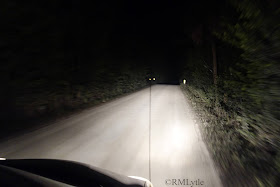It wasn't very long before I spotted a snake, a long skinny yellowish one, just on the right edge of the road. We hopped out to check it out. It was a yellow rat snake, which, though visually exceptionally different from our CT black rat snakes, is actually the same species, Pantherophis alleghaniensis or the Eastern rat snake. This individual, like our black rats at home, was a pleasure to handle but a pain to photograph. It never stopped moving and climbed all over me, which is fun, but makes nighttime photography essentially impossible. I got some voucher shots but nothing especially artistic.
We continued down the road expecting to find more snakes fairly quickly given how fast we found the first, and we did find frogs without covering too much more ground but it was a while before we saw another snake. The first frog we found was somewhat ambiguous but may be either a squirrel tree frog or an American green tree frog. I'd lean towards squirrel tree frog but I really don't know for sure.
The next snake we found, Noah spotted. It was a quite small one and had it not been moving it would have been very hard to spot. It was another more common species, but a colorful one and this time something I'd never seen in the wild, a corn snake.
 |
| Pantherophis guttatus |
 |
| That anyone could be afraid of this adorable little guy is beyond me. |
 |
| Anaxyrus terrestris |
Weirdly, people manage to find ways to be disgusted and scared of toads too, but soon we found the most unfairly maligned species of the night. The bulky body and head raised stance were tell tail, we had found our first cottonmouth, or water moccasin. I already wrote a post to dispel some of the myths about this species, find that here: The Myth of Agressive Snakes. But even I, having already been around lots of timber rattlesnakes an even handling copperheads, was a bit surprised by how generally relaxed and well behaved these were, the third species of pit viper I'd encountered in the wild. The first cottonmouth Noah and I found was not polite enough to stick around but didn't want anything more than to get away from us quickly. I failed to get any high quality images of this flighty snake....
We went a good many miles then without success. We found a roadkill ribbon snake and missed what was almost certainly another yellow rat snake, but it wasn't until a while later, when we happened to meet two more cars of herpers and an adult corn snake at the same moment that our luck again improved. We chatted for a bit, photographed the snake, then continued our separate ways. It was a fun little chance encounter in the middle of the Everglades at night.
I really wanted to find a colorful cottonmouth that was willing to sit still for me to get some great shots of it, and that's exactly what our final snake of the night turned out to be. It didn't posture, it didn't gape, it didn't strike... this gorgeous little moccasin just sat still with its head raised and let me shoot away until it was time to leave and usher him out of the road. It was perfect, and common though these snakes may be in the area I was thrilled.
 |
| Agkistrodon piscivorus |
Fish aren't all that I live for, and though they were probably the biggest draw of the Everglades the snakes were a close second. Unfortunately, years of development, indiscriminate killing, and collecting have diminished Florida's snake populations so much it's just a shadow of what it used to be. I was so thankful to have gotten to see the snakes we had on that firs night, and was excited for the days and nights to come.
Until next time,
Fish for the love of fish.
Fish for the love of places fish live.
Fish for you.
And stay safe and healthy.
Thank you to my Patrons; Erin, David, John, Elizabeth, Brandon, Christopher, Shawn, Mike, Sara, Leo, and Franky for supporting this blog on Patreon.









I'm surprised you didn't see more critters in that environment. Beautiful critters.
ReplyDeleteTie, fish, write, conserve and photo on...
What I photographed is a small fraction of what we saw, but still historically covering as much ground as we did may have turned up many more snakes.
DeleteSuper cool! What a really awesome trip to be on.
ReplyDeleteWill (Hibernation)
It was a hell of an adventure.
Delete